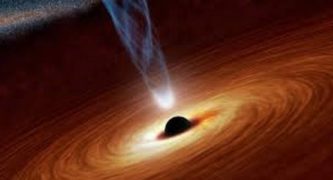 Caltech scientists may have spotted light emanating from a pair of coalescing black holes.
Caltech scientists may have spotted light emanating from a pair of coalescing black holes.
The event would mark the first time light has been seen coming from a merger of black holes
When two black holes spiral around each other and ultimately collide, they send out ripples in space and time called gravitational waves.
Because black holes do not give off light, these events are not expected to shine with any light waves, or electromagnetic radiation. But some theorists have come up with ways in which a black hole merger might explode with light. Now, for the first time, astronomers have seen evidence for one of these light-producing scenarios.
“This supermassive black hole was burbling along for years before this more abrupt flare,” said Matthew Graham, a research professor of astronomy at Caltech and the project scientist for ZTF. “The flare occurred on the right timescale, and in the right location, to be coincident with the gravitational-wave event. In our study, we conclude that the flare is likely the result of a black hole merger, but we cannot completely rule out other possibilities.” Graham is lead author of the new study, published in the journal Physical Review Letters.
With the help of Caltech’s Zwicky Transient Facility (ZTF), funded by the National Science Foundation (NSF) and located at Palomar Observatory near San Diego, the scientists have spotted what might be a flare of light from a pair of black holes.
The black hole merger was first witnessed by the NSF’s Laser Interferometer Gravitational-wave Observatory (LIGO) and the European Virgo detector on May 21, 2019, in an event called S190521g. As the black holes merged, jiggling space and time, they sent out gravitational waves.
While this was happening, ZTF was performing its robotic survey of the sky that captured all kinds of objects that flare, erupt, or otherwise vary in the night sky. One flare the survey caught, generated by a distant active supermassive black hole, or quasar, called J1249+3449, was pinpointed to the region of the gravitational-wave event S190521g.
“ZTF was specifically designed to identify new, rare, and variable types of astronomical activity like this,” says NSF Division of Astronomical Science Director Ralph Gaume. “NSF support of new technology continues to expand how we can track such events.”
In the scenario outlined by Graham and his colleagues, two partner black holes were nestled within a disk surrounding a much larger black hole.
“At the center of most galaxies lurks a supermassive black hole. It’s surrounded by a swarm of stars and dead stars, including black holes,” says co-author K. E. Saavik Ford of the City University of New York (CUNY) Graduate Center, the Borough of Manhattan Community College (BMCC), and the American Museum of Natural History (AMNH). “These objects swarm like angry bees around the monstrous queen bee at the center. They can briefly find gravitational partners and pair up but usually lose their partners quickly to the mad dance. But in a supermassive black hole’s disk, the flowing gas converts the mosh pit of the swarm to a classical minuet, organizing the black holes so they can pair up,” she said.
Once the black holes merge, the new, now-larger black hole experiences a kick that sends it off in a random direction, and it plows through the gas in the disk. “It is the reaction of the gas to this speeding bullet that creates a bright flare, visible with telescopes,” says co-author Barry McKernan, also of the CUNY Graduate Center, BMCC, and AMNH.
Such a flare is predicted to begin days to weeks after the initial splash of gravitational waves produced during the merger. In this case, ZTF did not catch the event right away, but when the scientists went back and looked through archival ZTF images months later, they found a signal that started days after the May 2019 gravitational-wave event. ZTF observed the flare slowly fade over the period of a month.
The scientists attempted to get a more detailed look at the light of the supermassive black hole, called a spectrum, but by the time they looked, the flare had already faded. A spectrum would have offered more support for the idea that the flare came from merging black holes within the disk of the supermassive black hole. However, the researchers say they were able to largely rule out other possible causes for the observed flare, including a supernova or a tidal disruption event, which occurs when a black hole essentially eats a star.
The newly formed black hole should cause another flare in the next few years. The process of merging gave the object a kick that should cause it to enter the supermassive black hole’s disk again, producing another flash of light that ZTF should be able to see.














 0 comments
0 comments


